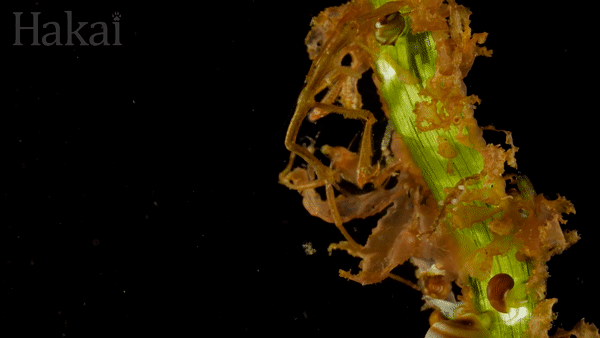It’s the Little Things…
One scientist's arduous journey to catch all the amphipods.

If you were on a hunt for every kind of beetle in a forest, you’d search the tree bark, turn over rocks, and dig in the soil. You’d certainly capture a lot of different species. But you could search every nook and cranny and still miss a bunch of biodiversity. Beetles are too good at blending in, hiding, and avoiding. In my research, the hunt is even harder. I’m not looking for beetles. I’m underwater searching for creatures no larger than a jellybean. I’m seeking my favorite kind of animal—amphipods.
Amphipods are proof that sometimes big things come from little animals. They are strange crustaceans related to crabs and shrimp, but with a thinner outer shell. More akin to kangaroo than crustacean, female amphipods use a brood pouch to protect their offspring. These wee weirdos are highly underrated. But despite their importance to the ecosystem as decomposers and food for everything from fish to gray whales, our knowledge of amphipods remains limited because they are so challenging to find. So I need to use multiple methods to improve my hunt for amphipods.
How Do I Find an Amphipod?

I have to twist and squirm to fit into the thick neoprene wetsuit, which protects me against the cold water. My SCUBA mask smells like kelp, and my snorkel is covered with the salty remnants of previous dives. By the time I jump into the ocean, I feel more like a claustrophobic penguin than a scientist. This is how each amphipod hunt begins.
Most often, I collect amphipods by hand. I dive down to the bottom and grab clumps of habitat that amphipods live on. I look on algae, turn over rocks, and dig into sand, placing whole bundles into a fine mesh bag. I’ll shake the creatures off back in the lab. I exhaust myself and my air supply searching for every kind of amphipod—yet, despite my efforts I know I miss some. They’re too small, too cryptic, too good at evading capture.
To catch more of those that my hands miss, I use homemade traps I make from common household items. A stiff horsehair brush or a scrubby dish sponge secured to metal anchors makes a surprisingly good amphipod catcher. I place traps in different ocean habitats and collect them a week or two later when amphipods have taken up residence. However, this real estate attracts very specific amphipod clientele. Once again, I know I miss some.
To catch as many species as possible, I need a better way of finding amphipods in their natural environment. When scientists search for a large animal on land, they look for its tracks. An amphipod doesn’t leave detectable tracks underwater, but they do leave behind pieces of DNA.
The Genetic Library
As an active kid, I loved to play in the ball pit at my favorite fast-food restaurant. I’d pretend to swim through the thousands of colorful plastic balls. Now, as a marine ecologist, the ocean is my massive ball pit. Instead of plastic, the balls are different molecules—water, nutrients, and bits of DNA that slough off animals, often referred to as environmental DNA or eDNA. It’s the DNA “balls” that come from amphipods that I’m most interested in finding.
Before I can use DNA from seawater to identify amphipods, I need to know what DNA belongs to which amphipod species. I need a DNA library. Years of research have generated a database of DNA sequences that serve as “barcodes”. When a sample of seawater comes, we try to match DNA in the water against known barcode sequences. At least, that’s the hope. Amphipods are extremely diverse, so the library is far from complete. Until the shelves are fuller, I’ll have to put on my bulky wetsuit again to add the missing volumes to the library’s collection.
Finding the Right Balls in the World’s Biggest Ball Pit

Even once the library’s shelves are filling up and ready to help match DNA to amphipod species, there’s still one big problem. How do you make sure you’re only pulling out amphipod balls in the big ball pit and not, say, DNA from crabs, cod, clam, and all sorts of other ocean creatures? I need some way to filter out the amphipods from the anemones. That’s where primers come in.
A primer binds to a specific chunk of animal DNA. We design primers for amphipods by lining up DNA sequences from different amphipod species and other kinds of animals. We search for which part of the DNA only amphipods have in common. Then, I mix these primers with a seawater sample and the primer only sticks to the amphipod DNA chunks. The primer-bound DNA is sequenced and compared to the barcode library to figure out which amphipod types are in the sample.
Finding Amphipods in the Future
It’s impossible to know what’s changing in an ecosystem unless we know what’s there in the first place. It’s my hope that using DNA will usher in a new era of amphipod research. If we have primers and a complete DNA library, we should be able to find more amphipods in their underwater habitats. This means less time searching for amphipods, and more time understanding their unique habitats, behaviors, and interactions with other animals. DNA is the key to closing our amphipod knowledge gap.

